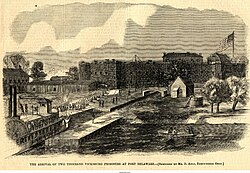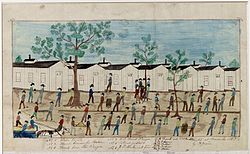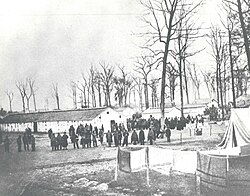Top Qs
Timeline
Chat
Perspective
American Civil War prison camps
Lists of prisoner of war camps From Wikipedia, the free encyclopedia
Remove ads
Remove ads
Between 1861 and 1865, American Civil War prison camps were operated by the Union and the Confederacy to detain over 400,000 captured soldiers. From the start of the Civil War through to 1863 a parole exchange system saw most prisoners of war swapped relatively quickly. However, from 1863 this broke down following the Confederacy's refusal to treat black and white Union prisoners equally, leading to soaring numbers held on both sides.

Records indicate the capture of 211,411 Union soldiers, with 16,668 paroled and 30,218 died in captivity; of Confederate soldiers, 462,684 were captured, 247,769 paroled and 25,976 died in captivity. Just over 5.6% of the captives in Northern prisons died, compared to 14.29% for Southern prisons.[1]
Lorien Foote has noted, "the suffering of prisoners did more to inhibit postwar reconciliation than any other episode of the war."[2]
Remove ads
Parole
Summarize
Perspective
Lacking means for dealing with large numbers of captured troops early in the American Civil War, the Union and Confederate governments both relied on the traditional European system of parole and exchange of prisoners. A prisoner who was on parole promised not to fight again until his name was "exchanged" for a similar man on the other side. Then both of them could rejoin their units. While awaiting exchange, prisoners were briefly confined to permanent camps. The exchange system broke down in mid-1863 when the Confederacy refused to treat captured black prisoners as equal to white prisoners. The prison populations on both sides then soared. There were 32 major Confederate prisons, 16 of them in the Deep South states of Georgia, Alabama, and South Carolina.[3] Training camps were often turned into prisons, and new prisons also had to be made. The North had a much larger population than the South, and Gen. Ulysses S. Grant was well aware that keeping its soldiers in Northern prisons hurt the Southern economy and war effort.
Prisoner exchanges

At the outbreak of the war, the federal government avoided any action, including prisoner exchanges, that might be viewed as official recognition of the Confederate government in Richmond. Public opinion forced a change after the First Battle of Bull Run, when the Confederates captured over one thousand Union soldiers.[4]
Union and Confederate forces exchanged prisoners sporadically, often as an act of humanity between opposing commanders. Support for prisoner exchanges grew throughout the initial months of the war, as the North saw increasing numbers of its soldiers captured. Petitions from prisoners in the South and editorials in Northern newspapers brought pressure on the Lincoln administration.[4] On December 11, 1861, the US Congress passed a joint resolution calling on President Lincoln to "inaugurate systematic measures for the exchange of prisoners in the present rebellion".[5] In two meetings on February 23 and March 1, 1862, Union Major Gen. John E. Wool and Confederate Brig. Gen. Howell Cobb met to reach an agreement on prisoner exchanges. They discussed many of the provisions later adopted in the Dix-Hill agreement. However, differences over which side would cover expenses for prisoner transportation stymied the negotiations.
Dix-Hill Cartel of 1862
Prison camps were largely empty in mid-1862, thanks to the informal exchanges. Both sides agreed to formalize the system. Negotiations resumed in July 1862, when Union Maj. Gen. John A. Dix and Confederate Maj. Gen. D. H. Hill were assigned the task. The agreement established a scale of equivalents for the exchange of military officers and enlisted men. Thus a navy captain or an army colonel was worth fifteen privates or ordinary seamen, while personnel of equal ranks were exchanged man for man. Each government appointed an agent to handle the exchange and parole of prisoners. The agreement also allowed the exchange of non-combatants, such as citizens accused of "disloyalty", and civilian employees of the military, and allowed the informal exchange or parole of captives between the commanders of the opposing forces.
Authorities were to parole any prisoners not formally exchanged within ten days following their capture. The terms of the cartel prohibited paroled prisoners from returning to the military in any capacity including "the performance of field, garrison, police, or guard, or constabulary duty".[6]
End of exchanges
The exchange system collapsed in 1863 because the Confederacy refused to treat Black prisoners the same as Whites. They said they were probably ex-slaves and belonged to their masters, not to the Union Army.[7] The South needed the exchanges much more than the North did, because of the severe manpower shortage in the Confederacy. In 1864 Ulysses Grant, noting the "prisoner gap" (Union camps held far more prisoners than Confederate camps), decided that the growing prisoner gap gave him a decided military advantage. He therefore opposed wholesale exchanges until the end was in sight. Around 5,600 Confederates were allowed to join the Union Army. Known as "galvanized Yankees" these troops were stationed in the West facing Native Americans.[8]
Prisoner exchanges resumed early in 1865, just before the war's end, with the Confederates sending 17,000 prisoners North while receiving 24,000 men.[9] On April 23, after the war ended, the riverboat Sultana was taking 1900 ex-prisoners North on the Mississippi River when it exploded, killing about 1500 of them.
Remove ads
Death rates
The overall mortality rates in prisons on both sides were similar, and quite high. Many Southern prisons were located in regions with high disease rates, and were routinely short of medicine, doctors, food and ice. Northerners often believed their men were being deliberately weakened and killed in Confederate prisons, and demanded that conditions in Northern prisons be equally harsh, even though shortages were not a problem in the North.[10]
About 56,000 soldiers died in prisons during the war, accounting for almost 10% of all Civil War fatalities.[11] During a period of 14 months in Camp Sumter, located near Andersonville, Georgia, 13,000 (28%) of the 45,000 Union soldiers confined there died.[12] At Camp Douglas in Chicago, Illinois, 10% of its Confederate prisoners died during one cold winter month; and Elmira Prison in New York state, with a death rate of 25%, very nearly equaled that of Andersonville.[13]
Remove ads
Main camps
Remove ads
See also
- Prisoner-of-war camp, worldwide history
- Henry Wirz, commander at Andersonville; executed for war crimes
- Parole camp
Notes
Bibliography
External links
Wikiwand - on
Seamless Wikipedia browsing. On steroids.
Remove ads

























